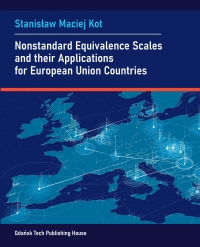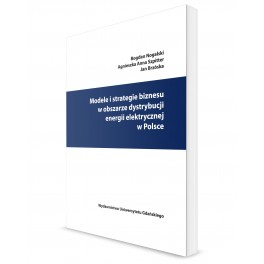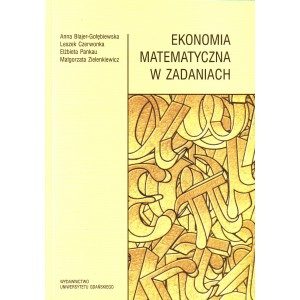Opis
Nonstandard Equivalence Scales and their Applications for European Union Countries
Wydawnictwo Politechniki Gdańskiej
Autor: Kot Stanisław Maciej
The aim of this study is twofold. First, we propose new methods of estimating equivalence scales. We call these methods nonstandard to distinguish them from the standard procedures based on the microeconomic theory of demand systems. Searching for the ‘as simple as possible’ method has been a leitmotiv of this study. Second, we estimate various forms of equivalence scales for 28 European Union (EU) member countries and four non-member European countries from 2004 to 2018.
This study represents the past several years of the author’s research on income distribution and draws heavily upon several of his published and forthcoming articles. The monograph format of this publication enables the presentation of many additional results, which usually cannot be placed in a typical paper due to limited space. It is noteworthy that material from these papers does not appear in precisely the same format as initially published; they have been edited to form a coherent whole.
Contents
Introduction….. 9
PART I MICROECONOMIC EQUIVALENCE SCALES AND DATA…11
1. An overview of the standard model of equivalence scales .12
1.1. Some preliminaries.. 12
1.2. Econometric equivalence scales ….. 13
1.3. Non-identification of the standard equivalence scales …14
1.4. Subjective equivalence scales….. 15
1.5. The parametric equivalence scales… 16
1.6. The collective household models …… 18
1.7. The sequential dominance approach….. 19
2. Statistical data ……21
2.1. The description of the EU-SILC database. … 21
2.2. The measurements of household welfare levels .. 22
PART II THE ESTIMATION OF THE RANDOM EQUIVALENCE SCALES …. 27
3. The random equivalence scales: a theoretical background….. 28
3.1. From a microeconomic perspective to a population perspective…. 28
3.2. The random equivalence scales for continuous income distributions …… 29
3.3. The random equivalence scales in the lognormal distribution of income…. 30
3.4. Ethical recommendations for the choice of a single equivalence scale…. 33
3.5. Some practical issues concerning the random equivalence scales… 36
3.5.1. The test of goodness-of-fit of the lognormal distribution …… 36
3.5.2. Possible dependence of RES on income ….. 37
3.5.3. Beyond lognormality…. 37
3.6. Summary . 38
4. Random equivalence scales for EU countries when household size accounts for needs…. 39
4.1. Preliminary remarks….. 39
4.2. Testing lognormality of disposable household incomes…. 39
4.3. Testing the dependence of the random equivalence scales on selected factors … 40
4.4. The ‘Rawlsian’ paradox … 45
4.5. The mean equivalent income and inequality in European countries …… 60
4.5.1. Preliminary remarks… 60
4.5.2. Mean income and inequality in the Central European Region …… 62
4.5.3. Mean income and inequality in the Social Democratic Region.. 67
4.5.4. Mean income and inequality in the Baltic Region…….. 73
4.5.5. Mean income and inequality in the Mediterranean Region .. 78
4.5.6. Mean income and inequality in the East European Region …… 83
4.5.7. Mean income and inequality in the Liberal Market Region ……89
4.6. Summary …… 94
5. Random equivalence scales respecting demographic composition …… 95
5.1. Selecting groups of households …… 95
5.2. Estimating random equivalence scales…….. 95
5.3. The Rawlsian paradox…… 99
5.4. Summary……107
PART III THE ESTIMATION OF PARAMETRIC EQUIVALENCE SCALES……109
6. The estimation of the one-parameter equivalence scale ……110
6.1. Preliminary remarks…..110
6.2. The method of estimating BRSS equivalence scales…..113
6.3. Empirical results……117
6.3.1. The results of estimating BRSS …..117
6.3.2. Regional differences between BRSS…..121
6.4. Checking changes of country BRSS over time…….128
6.5. Some curiosities in the behaviour of the (Gu,θu) relationship over time..135
6.6. Summary…….139
7. The estimation of the two-parameter equivalence scales…..141
7.1. Preliminary remarks….141
7.2. The numeric method of estimating the OECD and the C-K equivalence scales …141
7.3. The analytical method of estimating the OECD and the C-K equivalence scales…..145
7.4. The empirical results of estimating the OECD scales.146
7.5. Empirical results of estimating C-K equivalence scales……155
7.6. Summary……168
8. The global income distribution for the European Union ….170
8.1. Preliminary remarks……….170
8.2. The EU income distributions when household size accounts for needs……..171
8.3. The EU income distribution when household demographics account for needs …185
8.4. Summary….197
Final summary ….199
Bibliography …..201
Appendix 2…..206
Appendix 4….219
Appendix 5…..301
Appendix 6….359
Appendix 7….369











Opinie
Na razie nie ma opinii o produkcie.